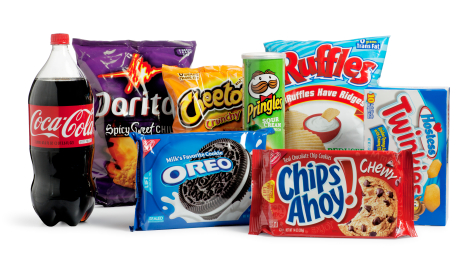What are Non-Foods?
Processed & Genetically Modified Foods
Most of the shopping carts across not only in America but also in many grocery stores around the world are filled with what could be referred to as non-foods. A non-food is any food that costs more in nutritional value to digest, absorb, and eliminate than it delivers. Non-food items includes most processed foods like cookies, cereals, bread, granola bars, ramen noodles, flavored nuts, fruit snacks, most salad dressings or sauces, and margarine – just to name a few. Non-foods are also foods that have been genetically modified (GMOs) including seeds or nuts, grains, beef, pork, lamb, poultry, fruit and vegetables, wheat/wheat flour, eggs (in the shell), herbs and spices, and dried vegetable seasonings. If you’re looking to put on some weight and worsen your health then look no further non-foods are the choice for you. But, I’m guessing that not what you’d like. So, avoid these non-food products as much as you can and start with getting rid of processed food items.
Avoid Processed Foods
Strange Words & Various Concoctions
I’d be willing to bet that if you go to your cupboard or refrigerator right now and have a look you find some, if not many, processed foods. Take a look at the labels of these products and see how many ingredients you either can’t pronounce or don’t have the slightest clue what they are. These often gigantic and strange words listed on the label are the various concoctions used to color, stabilize, emulsify, bleach (why does food need to be bleached?), texture, soften, preserve, sweeten, add or cover smells, and the word of the manufacturer uses, flavor! You may be wondering just how many of these little chemicals are sneaking their way into your mouth. The US Food and Drug Administration (FDA) currently lists almost 4,000 substances that are added to Food in the United States. Of those 4,000 most are food additives and chemicals1 most of which have some very serious health implications.2
Generally Regarded as Safe. Not An Objective Method?
Some of you may be on it and already read labels to avoid chemicals or food additives. Well I have some bad news, you may very well be getting duped. Since the FDA doesn’t require any food additive Generally Regarded as Safe (GRAS) to be listed on the label. All you’ll see on the label are the terms “artificial flavor,” “artificial coloring,” or they can even use the word natural as in “natural and “artificial flavors,” or “natural flavors.” And before you get comfortable with what’s on the GRAS list, you should know that to save time and money the FDA allows the food and additive manufacturers to notify them of the GRAS status of their additives and they’re allowed to provide their own evidence to support their claim!3 This would be similar a cigarette or drug manufacturer to make sure they provide proof that their products are safe.
Additives On the GRAS List, Often Stay on the GRAS List
This may shock you, but we are all, essentially, a part of the largest “study” in history. This “study” is still ongoing and we, the general public, are the guinea pigs for determining what’s Generally regarded as Safe. For, an additive is only removed from the GRAS list only after reports accumulate citing it’s damaging effects. Which doesn’t happen often due to fact that these additives are listed as natural or artificial flavors. So, what are the chances of a doctor notifying the FDA that a patient suffered adverse reactions to acetaldehyde, acetic acid or agar when none are listed on the label? Yep, I think we agree the chances would be slim to none.
Avoid Genetically Modified Foods (GMOs)
What is Genetic Modification (Engineering)?
Genetically modified foods are another form of what I consider to be a non-food. Genetic engineering (GE), also called genetic modification (GM) is the manipulation of plant and animal development by altering the gene expression.4 The products of genetic modification are what we refer to as genetically modified organisms (GMOs). Most genetically engineered crops planted worldwide are designed to either survive exposure to a certain herbicide or to kill certain insects. One of the major problems with this is the mechanisms by which it works or doesn’t work are not even completely understood by scientists themselves. Genetic engineers certainly know much more about genetics than you or I, but they don’t actually know with certainty what will result from their manipulation of genes, otherwise known as Mother Nature’s laws. These genetic engineers are essentially playing a game of “let’s see what happens” with some set guidelines.
Genetic Engineering Has Real Concerns
While the mechanisms that take place in GE are extremely complicated, it’s safe to say that there are some real concerns. For one GE can introduce an allergen into a food that previously did not contain it. An example would be a soybean engineered with the genes from a Brazil nut, designed to make it tastier, was found to produce allergic reactions in people with nut allergies. Who could have saw that coming, I wonder? When genetic engineering causes a familiar food to start producing a substance, previously not present in the human food supply, it becomes impossible to know who may have an allergic reaction to it.
Shady Stuff?
Lack of quality research supporting GM crops should be a real concern to many. But, Arpad Pusztai has conducted one of the most comprehensive animal studies on the consumption of GM foods, specifically GM potatoes.5 Pusztai’s research found that genetically engineered foods may also produce unexplained health effects in laboratory animals. The GM potato used in his studies was modified to contain Galanthus Nivalis Agglutnin (GNA), ordinarily found in snowdrops (a type of flower), which served to increase the plant’s resistance to certain insects and other pests. These GM potatoes were associated with abnormal organ development and immune responsiveness in rats, the subjects of this study. Pustazi reported his findings in a television interview. He stated that “It is very unfair to use fellow citizens as guinea pigs. Guinea pigs should be in the laboratory, and GE foods should be properly tested before they are approved for the market.” Pustazi began his studies to prove that, for everyone’s sake, GM foods were safe. Instead, we he exposed the results of his studies that proved otherwise, he lost his funding and assistants.5 Some shady stuff had gone down behind the scenes if you ask me.
- https://www.accessdata.fda.gov/scripts/fcn/fcnNavigation.cfm?rpt=eafusListing
- https://ctajournal.biomedcentral.com/track/pdf/10.1186/s13601-015-0078-3?site=ctajournal.biomedcentral.com
- https://www.npr.org/sections/thesalt/2015/04/14/399591292/why-the-fda-is-clueless-about-some-of-the-additives-in-our-food
- https://www.ncbi.nlm.nih.gov/pmc/articles/PMC3791249
- https://www.ncbi.nlm.nih.gov/pmc/articles/PMC1115659/
Fact of the week
Mycotoxins are toxic substances produced by fungi and are linked to diabetes, obesity, and kidney disease.6
Unfortunately, mycotoxins are widespread in wine and in other processed foods like grains. One study found a certain mycotoxin called fumonisin B(2) in 23 percent of wines tested from 13 countries.7
- https://www.ncbi.nlm.nih.gov/pmc/articles/PMC164220/
- https://www.ncbi.nlm.nih.gov/pubmed/20201553

